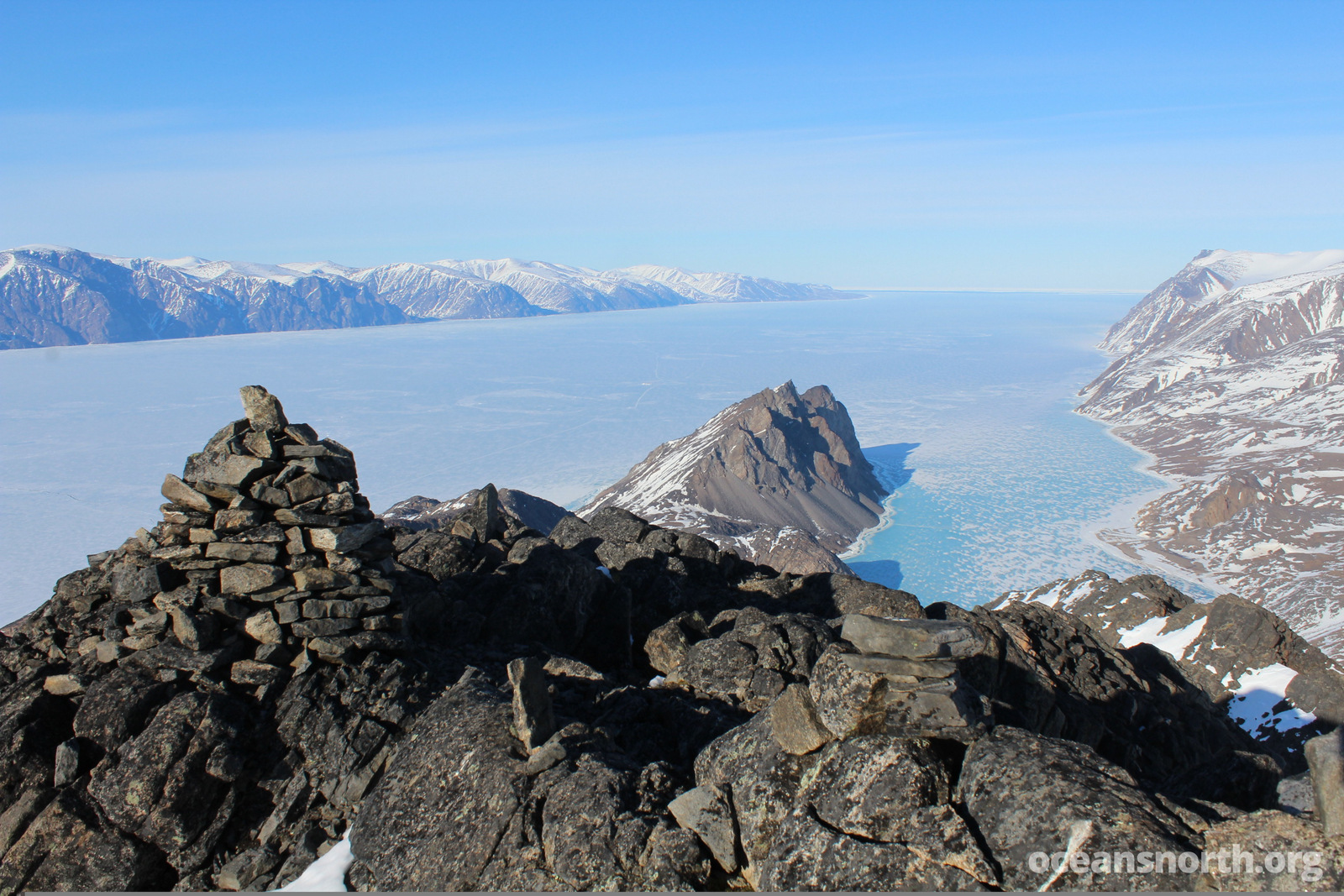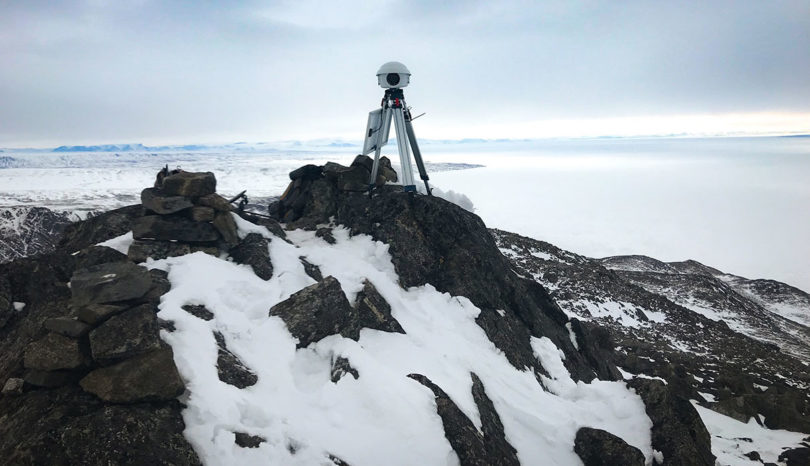Each spring since 2016, Oceans North has installed two time-lapse cameras on Mount Herodier above Tasiujaq (formerly Eclipse Sound), Nunavut, to monitor sea ice conditions before, during and after breakup.
Current Ice Conditions
Our cameras provide images of near real-time sea-ice conditions to local residents and help researchers study the breakup of landfast ice, as well as assess the impacts of icebreaking and shipping in the area.
The floe edge is of particular interest, as this is the zone where landfast ice meets open water and is an area of high biological productivity. Our study has been ongoing since 2015 in various locations around Tasiujaq and the floe edge.
Note: Due to Covid-19 travel restrictions, we could not service the camera sites in 2020. Both cameras have shut down for now, and we will retrieve the instruments once it is safe, likely in the winter of 2021. Until then, we will work with the community of Mittimatalik (Pond Inlet) to determine how to proceed with this project.
Most Recent Images
The cameras are set up to deliver images every two hours, depending on network conditions. Below is an automatically updated collection of the most recent 12 images. Longer time gaps between images occur when incomplete or failed transfers occur. Snow and ice on the camera housing occasionally obscures images. Images appear in reverse chronological order from left to right, most recent on the left.
In the event that the most recent images are obscured due to weather conditions, jump to the bottom of this page to see each camera’s view on a clear day.
Time-Lapse Video
EclipseCam
EclipseCam returned to life this spring when enough sunlight had recharged its batteries. It’s on the same two-hour schedule as last summer and delivering photos regularly. If you’re looking to see this year’s breakup, EclipseCam caught it.
FloeCam
When FloeCam came back to life in May 2019, it began taking a photo every five minutes instead of every two hours. However, it can’t deliver that many images each day so it “bursts” when connectivity permits.
2018
For the 2018 field season, our cameras ran from June 1st to September 19th before powering down in the face of extreme weather and limited daylight. Below is a time-lapse video created from images taken by our FloeCam during that period.
2016
This project is part of a several year study of the landfast ice and floe edge dynamics of Pond Inlet. Below is the timelapse footage from 2016.
How the Cameras Work
The time-lapse cameras capture images of the floe edge and Tasiujaq every two hours.
Each camera system consists of a weather-proof box that houses the cameras, time-lapse controllers and high-capacity batteries, all of which are charged and powered by 20-watt solar panels.
The cameras transmit images to the Oceans North server over a cellular network via USB cellular sticks. This allows images to be shared in near real-time with the community of Pond Inlet, researchers and Arctic enthusiasts. Photos are posted on this webpage as well as a touch screen at the Nattinak Visitors Centre in Pond Inlet. Our project is conducted with the help of hunters and others from Pond Inlet and is permitted under the Nunavut Research Institute.
Working in this remote region presents challenges. The camera equipment must withstand harsh weather conditions that can cause the lenses to ice up, and image transfers are occasionally incomplete or lost due to inconsistent cellular connectivity. Unfortunately the installation site is too remote to allow for regular maintenance of the systems, apart from visits in the spring and fall.
Camera Positions
The two cameras, seen here positioned atop Mount Herodier, point toward Tasiujaq to the west and the floe edge to the east.
Two time-lapse cameras are installed on Mount Herodier, one overlooking Tasiujaq and the other the floe edge. The camera housings are mounted on sturdy tripods, which are anchored in place to withstand the extremely windy and harsh conditions.
Credit: Patricia Chambers
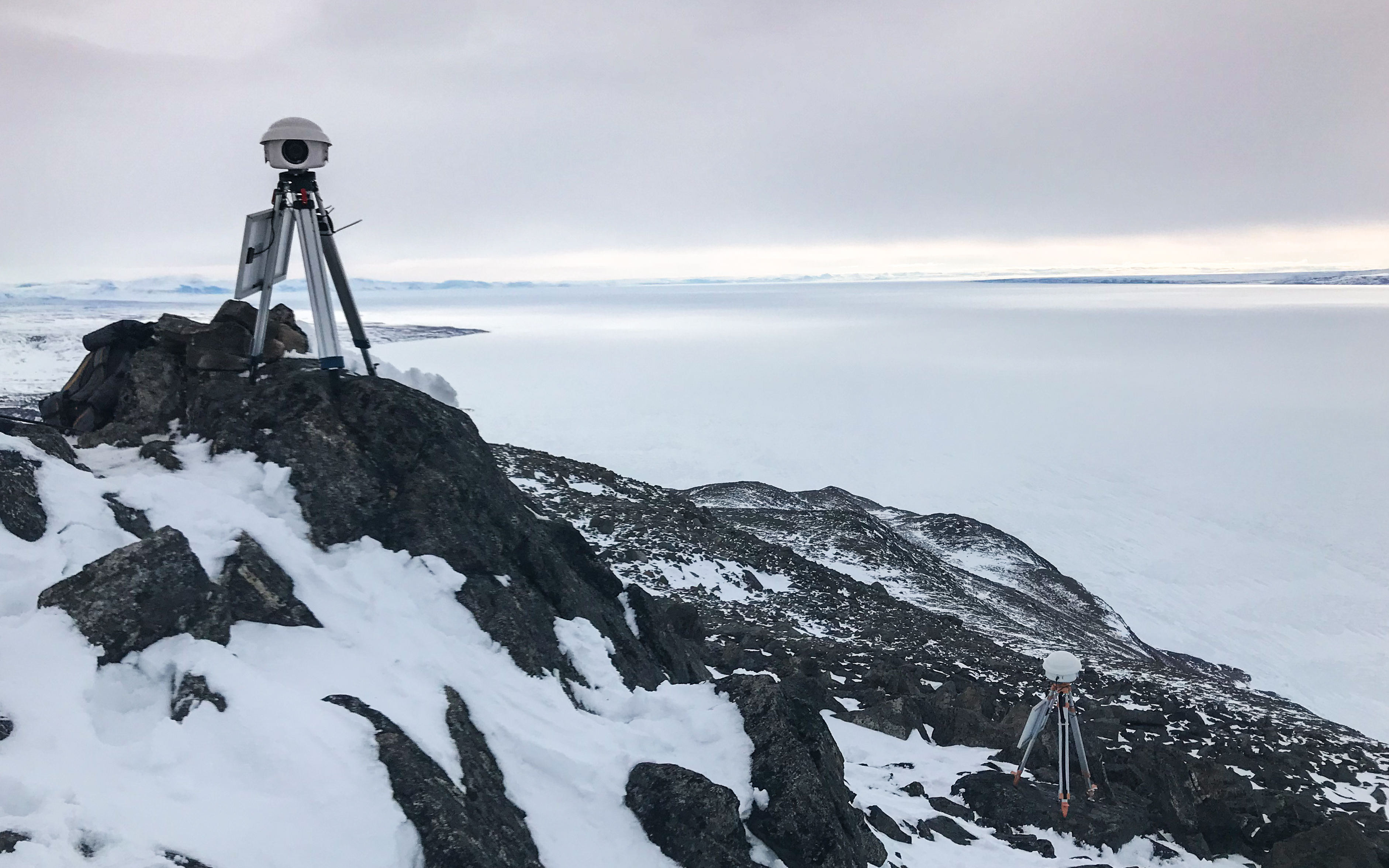
Two time-lapse cameras are installed on Mount Herodier, one overlooking Tasiujaq and the other the floe edge. The camera housings are mounted on sturdy tripods, which are anchored in place to withstand the extremely windy and harsh conditions.
Credit: Patricia Chambers
This birds-eye view shows the cameras’ positions and fields of view with respect to the surrounding landscape.
The time-lapse cameras are located near the summit of Mount Herodier, roughly 17 kilometres west of Mittimatalik (Pond Inlet). One camera points to the east toward the floe edge, and the other is oriented WNW, overlooking the eastern end of Eclipse Sound. The yellow arrows and semi-transparent white triangles on the map show the cameras’ orientations and fields of view. (Landsat imagery courtesy of Natural Resources Canada)
Credit: Oceans North
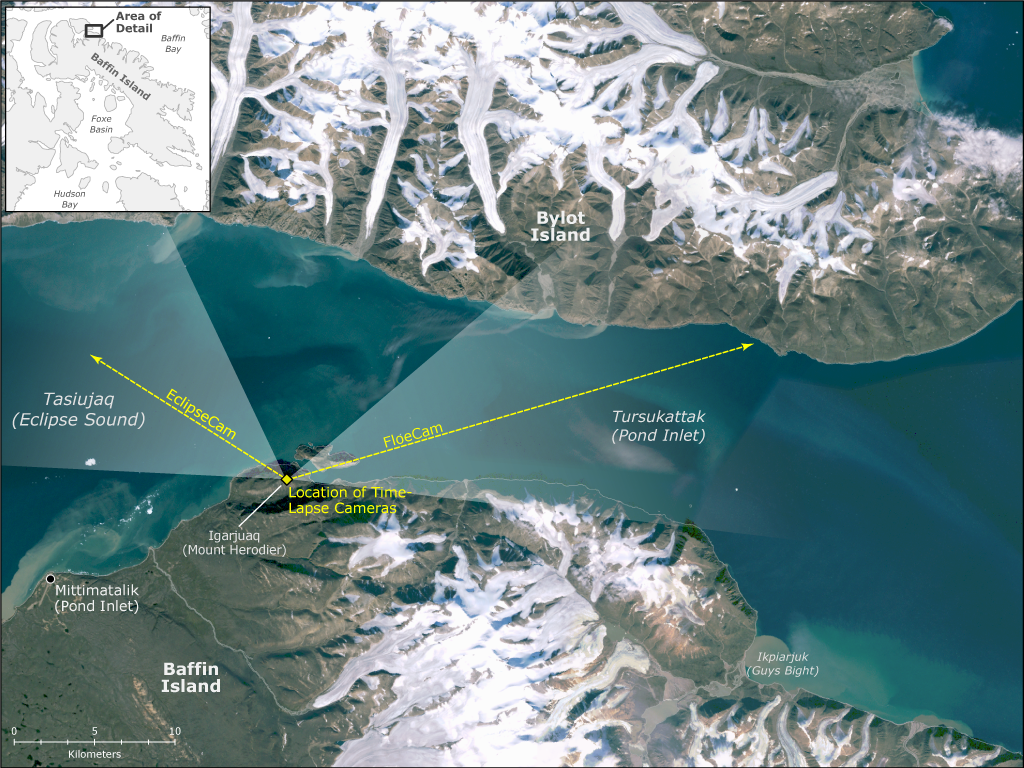
The time-lapse cameras are located near the summit of Mount Herodier, roughly 17 kilometres west of Mittimatalik (Pond Inlet). One camera points to the east toward the floe edge, and the other is oriented WNW, overlooking the eastern end of Eclipse Sound. The yellow arrows and semi-transparent white triangles on the map show the cameras’ orientations and fields of view. (Landsat imagery courtesy of Natural Resources Canada)
Credit: Oceans North
Installing the Cameras
Our team transports the equipment to the sites by snowmobile and on foot in late May or early June. In the fall, the cameras are usually retrieved by boat and foot. In 2018, the cameras will be left out over the winter with the hope of capturing the formation of landfast ice. The equipment will shut down when the Arctic days become too short to recharge the batteries.
Installing the cameras requires a lot of fine-tuning to get everything set up correctly. The 20W solar panels mounted on each tripod will keep the systems charged through summer and into the fall.
Credit: Patricia Chambers
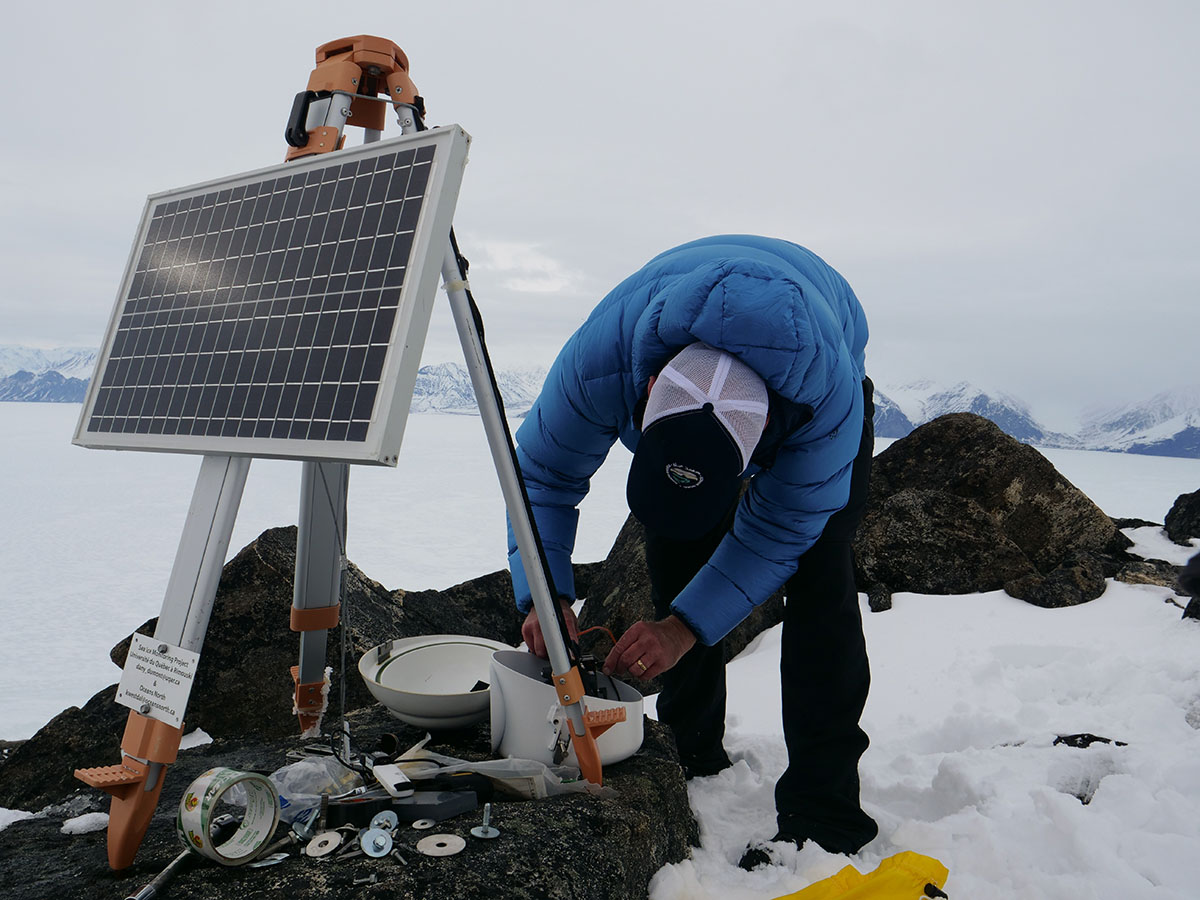
Installing the cameras requires a lot of fine-tuning to get everything set up correctly. The 20W solar panels mounted on each tripod will keep the systems charged through summer and into the fall.
Credit: Patricia Chambers
For a detailed story about our installation trip in 2018, visit our blog post.
Our Research Partners
This research is being conducted in collaboration with Dr. Dany Dumont of the Université du Québec à Rimouski. Dumont’s team at Institut des sciences de la mer de Rimouski (ISMER) plans to use the images in conjunction with satellite and environmental data to study the breakup of landfast ice in the area. Over time, they hope to use this information to accurately predict ice breakup in the region, as well as farther north. Results will be shared with the community as they become available.
Clear-Day Views from Each Camera
View from the Eclipse Sound-facing camera on a clear day (June 14, 2018).
Credit: EclipseCam/Oceans North

View from the Eclipse Sound-facing camera on a clear day (June 14, 2018).
Credit: EclipseCam/Oceans North
View from the floe edge-facing camera on a clear day (June 11, 2018).
Credit: Oceans North
View from the floe edge-facing camera on a clear day (June 11, 2018).
Credit: Oceans North
